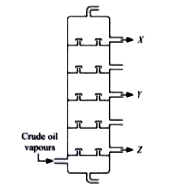When petroleum is heated in a fractionating column, various fractions are obtained at various heights of the column. More volatile liquid goes upto the top and least volatile liquid remains at the bottom. Various gaseous fractions are condensed according to their boiling points.
Which will condense near the top, petrol, diesel oil, fuel oil or kerosene?
Petrol
Diesel oil
Fuel oil
Kerosene
The correct Answer is:A
Petrol condenses near the top of the column since it is more volatile than other three.
Topper's Solved these Questions
- COAL AND PETROLEUMBOOK - MTG IIT JEE FOUNDATIONCHAPTER - COAL AND PETROLEUMEXERCISE - EXERCISE (VERY SHORT ANSWER) LEVEL 2
15 Videos
- COAL AND PETROLEUMBOOK - MTG IIT JEE FOUNDATIONCHAPTER - COAL AND PETROLEUMEXERCISE - EXERCISE (SHORT ANSWER) LEVEL 2
10 Videos
- COAL AND PETROLEUMBOOK - MTG IIT JEE FOUNDATIONCHAPTER - COAL AND PETROLEUMEXERCISE - EXERCISE (ASSERTION & REASON) LEVEL 2
10 Videos
- ATOMS, MOLECULES AND ATOMIC STRUCTUREBOOK - MTG IIT JEE FOUNDATIONCHAPTER - ATOMS, MOLECULES AND ATOMIC STRUCTUREEXERCISE - EXERCISE ( Integer/Numerical Value Type)
5 Videos
- COMBUSTION AND FLAME BOOK - MTG IIT JEE FOUNDATIONCHAPTER - COMBUSTION AND FLAME EXERCISE - OLYMPIAD/HOTS CORNER
15 Videos
Similar Questions
Knowledge Check
When petroleum is heated in a fractionating column, various fractions are obtained at various heights of the column. More volatile liquid goes upto the top and least volatile liquid remains at the bottom. Various gaseous fractions are condensed according to their boiling points.
As the gas reaches at the height where temperature is equal to or just below its boiling point it willAcondense to form a liquidBremain in gaseous stateCcondense to form a solidDescape from the column.When petroleum is heated in a fractionating column, various fractions are obtained at various heights of the column. More volatile liquid goes upto the top and least volatile liquid remains at the bottom. Various gaseous fractions are condensed according to their boiling points.
What can you say about the boiling points of liquids that collect at the bottom as residue?ATheir boiling points must be very low.BTheir boiling points must be much higher than the temperature at the bottom of the column.CTheir temperature is equal to the temperature of columnDNone of the above.Assertion : Petrol is more volatile than diesel oil.
Reason : Petrol condenses near the top of the column than diesel oil.AIf both assertion and reason are true and reason is the correct explanation of assertion.BIf both assertion and reason are true but reason is not the correct explanation of assertion.CIf assertion is true but reason is false.DIf both assertion and reason are false.
The liquid air has three components X,Y and Z whose boiling points are : −186∘C,−183∘Cand−196∘C, respectively. When liquid air is fed into a tall fractional distillation column from near its bottom and warmed up slowly:
(a) Which component will be collected from near the bottom of the fraction distillation column ? Why ?
(b) Which component will be collected from the top part of the fractional distillation column? Why ?
(c) Which component will be collected from the middle part of the fractional distillation column? Why ?
(d) What could the component X, Y and Z be?
View SolutionIn this section, each item consists of six sentences of a passage. The first and the sixth sentences are given in the beginning as S1 and S6. The middle four sentences in each have been jumbled up and labelled P, Q, R and S. You are required to find the proper sequence of the four sentences
S1: Crude oil obtained from the field is taken to a refinery for treatment.
S6: Lubricating oils of various grades are obtained last of all
P: The gas that comes off later is condensed into paraffin.
Q : This allows substances with different boiling points to be separated.
R : The first vapours to rise when cooled provide the finest petrol.
S: The commonest form of treatment is heating.
The proper sequence should be:
View SolutionThe given diagram represents a fractionating column where petroleum is separated into various fractions. Arrange the fractions X, Y, Z in order of decreasing boiling point range and identify the fraction that condenses first.

View SolutionStatement 1: During fractional distillation of petroleum, the temperature increases inside the fractionating column on going from bottom to the top.
Statement 2: The fraction with the lower boiling point condenses first.
View SolutionDuring the separation of acetone from water by fractional distillation, the following steps are carried out. Arrange the following in a proper sequence.
(1) Water remains in the distillation flask.
(2) The acetone-water mixture is taken in a distillation flask and the flask is heated at a temperature equal to or more than the boiling point of acetone but less than that of water.
(3) As the vapours pass through the fractionating column, they get condensed and the liquid formed is collected in the receiver.
(4) When the mixture in the flask is subjected to slow heating, acetone, being more volatile than water, gets vaporised first.
View Solution
